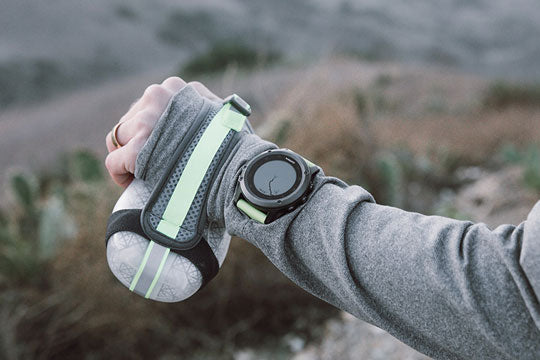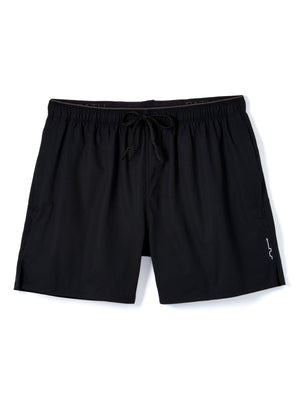Written by Sarah McMahon.
Hydration and fueling during long training runs and races is important for runners of all levels. With a copious amount of conflicting information available, it can be difficult to determine what is right or necessary for your body. Adequate nutrition and hydration is important before, during, and after long training rungs, and finding the right balance for your own body will require a bit of trial and error.
Here, we break down the how, why, and what to use to fuel during your harder, longer miles.

Hydration for running
Every runner knows that hydration is important, but the intricacies of hydration can seem overly complex: how much water is too much, how much is too little, should you also be drinking electrolytes? If so, when?
A good rule of thumb is to hydrate until your urine is clear or pale yellow, especially the day before a long trail run or race. The exact amount of water needed to attain clear pee will vary for everyone, but it’s important not to start a run dehydrated.
During a long trail run, you’ll want to take water with you, either in a handheld or pack. Some popular brands are Nathan, Salomon, UltraAspire and Ultimate Direction. To keep bladders clean, you can wash them out with dish soap and store them empty in your freezer. There are dozens of brands and companies that make hydration devices, so finding one that fits your body and is easy for you to use will require trying a variety of products.
How much water to drink on your runs?
How much water you take with you will depend on the length of your run and how much water you personally like to drink. Scientific evidence shows that the best way to avoid overhydration or underhydration is simply to drink to thirst. Steve Acciarito from Orange Mud confirms this philosophy, “I think people tend to overthink hydration. I always ask people two questions when they stop at my booth: How far do you run, and how much water do you drink? I can run 10 miles and barely need water, while someone else might drink a liter. It’s very personal.”
A general guideline for fluid consumption during a run is taking in 4 to 6 fluid ounces every 20 minutes. Of course, this may change depending on heat, and during runs longer than 90 minutes, an electrolyte such as Nuun or Gatorade may be helpful. However, since everyone sweats at a different rate, electrolytes may or may not be necessary for you. If you want to get a clearer idea of how much fluid you lose during a run, you can figure out your “sweat rate.” To do so, weigh yourself nude before a timed training run and then again after. One pound of weight loss equals 1 pint of water loss. So, if you lose 2 pounds during an hour run, you may want to consume 2 pints of fluid, especially in hot or humid conditions. You can also make up this fluid loss after a run by drinking 20 to 24 ounces of fluid for every pound lost.
Salt and electrolyte pills for running
If you’re running for an extended period of time or training for an ultramarathon, ironman, or other endurance event, salt tablets should be an essential component of your repertoire. When you sweat, you don’t only lose water, but also electrolytes. If you only drink water during extreme exertion, you may develop an electrolyte imbalance as your remaining electrolytes will be diluted. Once you have an electrolyte imbalance, the water that you do drink will not be absorbed by the stomach.
Salt Sticks are a popular salt tab that provide 215 mg sodium, 63 mg potassium, 14 mg calcium, 22 mg magnesium, as well as 100 IU Vitamin D to help the body absorb and utilize calcium. If you run for more than two hours or work out intensely in the heat, it’s a good idea to have some type of salt tablet on hand to avoid hyponatremia (low sodium concentration in the blood). Good salt supplements aim to mimic the electrolyte composition of human blood plasma, so that they replace what’s lost through perspiration.

Nutrition
While electrolyte beverages such as Gatorade may suffice for some people, you might like additional fuel at some point during your long run. One nutrition guideline is to ingest 30 to 60 grams of carbohydrate each hour you run longer than 75 minutes. This equates to about 200–300 calories per hour, which can be easily met by utilizing pre-packaged energy gels, bars, and chews come in portion sizes that make consuming adequate nutrition simple. Examples here are GU gel, Spring Energy gel, RX bars and Clif Bars. During a 2-hour training run, you may only need to fuel once or twice.
However, some runners experience gastrointestinal distress when using highly processed gels, bars, and chews. You may have better luck ingesting real food, such as pureed sweet potatoes, dates, bananas, or fruit purees. Many runners also subscribe to low-carb, paleo, or keto diets and high-sugar gels or chews may not be appropriate. Packets of peanut butter or almond butter are good sources of sustainable fuel for those following low-carb diets. Ucan and Vespa are popular options as well.
Other runners may prefer to run fasted and can sustain a low-intensity effort for hours without any fuel whatsoever. When you have developed your fat burning abilities well, your body is capable to running for hours using stored body fat as main energy source. Running fasted over time can make our bodies more efficient at burning fat for energy, which can be especially useful for long endurance training and racing. Running fasted is less more effective in an anaerobic state than an aerobic state, so reserve fasted runs for long, low-intensity efforts.
Food, much like hydration, is very personal and you should try several different fueling methods during training runs prior to race day. To avoid gastrointestinal distress, make sure to follow your food with a bit of water.
As you try new ways to fuel during your runs, keep track of how you felt with each method. No two products are alike, and it really takes some trial and error to figure out what works best for you. If you know you have a hard time eating solid foods when running, try drinking your calories with a product such as Maurten, TailWind and Carbo Pro. Additionally, it can be easy to lose track of time when you’re out on the trails, so some runners like to set a timer on their watch to sound an alarm every 20-30 minutes as a reminder to eat and/or drink.
Be Prepared
Whenever going for a long training run, it is highly advisable that you prepare for worst-case scenarios. Carry more water and fuel than you think you’ll need, especially if you’re running on an unfamiliar trail. A small, portable water filter may also be helpful in case you get lost or run out of water. It’s also a good idea to carry your phone, and your ID in case anything should happen.
Resources- https://www.verywellfit.com/hydration-and-running-2911541
- http://www.triathlon-hacks.com/salt-tablets-runners/
- https://www.amazon.com/dp/B006QF3TW4/
- https://www.runnersworld.com/nutrition-weight-loss/a20794621/how-to-eat-during-long-runs/
- https://www.rei.com/learn/expert-advice/trail-running-nutrition-basics.html
- https://www.camelbak.com/en/packs
- http://saltstick.com/
- https://carbopro.com/
- https://womensrunninguk.co.uk/nutrition/low-carb-diets-running/
- https://muirenergy.com/
- https://www.podiumrunner.com/train-body-fuel-efficiently_101145
Written by Sarah McMahon from The Prosiest.
------------------------------------------
Sign up for our email to be the first to know when new Trail Running articles come up.
You might also enjoy:
- TRAIL SAFETY FOR MOUNTAIN LION ENCOUNTERS AND ATTACKS
- TRAIL SAFETY FOR BEAR ENCOUNTERS AND ATTACKS
- TRAIL SAFETY FOR SNAKE ENCOUNTERS AND SNAKE BITES






1 comment
TAHOE CL 5" BASE LINER and SYKES PX 7" SHORT